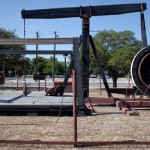How the Natural Gas Industry Is Responding to the EPA Fracking Contamination Report
It’s been only a few days since the EPA released draft findings of contamination by hydraulic fracturing (“fracking”) drilling operations in Wyoming, and already the industry is attempting to drill holes in the EPA’s findings. Residents near the drilling sites in Pavillion, Wyoming asked the EPA three years ago to investigate possible contamination after noticing water from their wells started tasting and looking off. So what has been the industry’s response?
- Question the evidence. The company behind the alleged contamination, Encana, clearly hopes to discredit the EPA’s findings. In a lengthy press release Monday, the company said the EPA’s findings are “irresponsible” and full of discrepancies. The EPA’s “conclusions do not stand up to the rigor of a non-partisan, scientific-based review,” the company said, but Encana doesn’t say if that scientific review has been performed or not. (The EPA released the findings in draft form to allow public input and scientific review, which they say is standard practice.) And while attempting to discredit many of the EPA’s discoveries, Encana also points to other EPA evidence as vindicating. “The EPA’s reported results of all four phases of its domestic water well tests do not exceed federal or state drinking water quality standards for any constituent related to oil and gas development,” the Encana release states.
- The chemicals are there naturally. StateImpact Pennsylvania, a sister site in the StateImpact network, published an email from Chesapeake Energy CEO Steve Dixon to his employees. Chesapeake is one of the bigger players in the fracking world, and claims on its website that it is “the second-largest producer of natural gas” and “most active driller of new wells” in the country. While accusing the EPA of making several causal links, Dixon makes one of his own, saying that the elevated levels of methane, benzene and other petrochemical compounds found in EPA monitoring wells are naturally occurring because the wells were drilled “into hydrocarbon-bearing zones.” (He paraphrases a line from Encana’s press release, saying “fracking did not put [those chemicals] there, nature did.”) Dixon says that he thinks the EPA is “more interested in their PR strategy and in establishing a connection between hydraulic fracturing and water contamination than in finding the truth.” Dixon also lauds the industry’s “sterling record of responsible hydraulic fracturing” and says that his company “meets or exceeds all regulatory requirements and continues to lead best practices in our industry.” The Pennsylvania Department of Environmental Protection gave Chesapeake the largest fine in history for a tank fire and contaminating wells in February in Pennsylvania, according to StateImpact Pennsylvania. And a Chesapeake well “spilled hundreds of thousands of gallons of fracking fluid” earlier this year.
- Wyoming is an outlier. The Houston Chronicle talks to industry analysts and finds what could be another blueprint for questioning the study: the gas wells in Wyoming were drilled under circumstances not found in most other fracking sites, with shallower wells, closer to water sources. Some of the fracking wells were drilled at around 1,200 feet, while most other shale drilling sites are between 4,000 and 14,000 feet underground, well below water sources. So some in the industry may not plan to debunk the report, but instead point out that the Wyoming case is unique.
- States are the best regulators. The Houston Chronicle also reports that the chairman of the Railroad Commission of Texas, which oversees drilling in the state, said that the findings in Wyoming have nothing to do with fracking in Texas. “The geology of Texas is different,” Elizabeth Ames Jones said. “Hydraulic fracturing does not go on close to the surface here and it would be impossible to migrate up from miles below the earth to a water table,” she said. “We have stringent rules on well construction and extra precautions must be taken near water tables. There is no reason to apply this EPA finding in Wyoming — regardless of what the results end up proving to be — in Texas.” Jones is the subject of a recent report by Greenwire that found that she “gets more campaign contributions from oil and gas than from any other industry.” Greenwire reports that Jones has received at least over a million dollars in campaign donations from the industry.
The EPA report is now in a public comment period for 45 days, and will be in a peer-review by independent scientists for 30 days. The EPA told StateImpact Texas that there will not be a moratorium on drilling at the Wyoming site while the findings are under review.
Here is the full EPA report on groundwater contamination linked to fracking in Wyoming:




